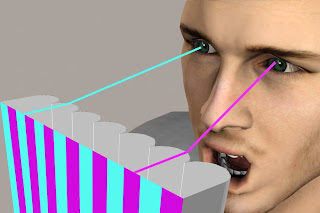 A Very Simplified Illustration - The cyan stripes represent View 1 and the magenta stripes View 2. Most lenticular prints are made from anywhere between 10 - 30 views. (It was too much work to make even 10 stripes per lenticule)
A Very Simplified Illustration - The cyan stripes represent View 1 and the magenta stripes View 2. Most lenticular prints are made from anywhere between 10 - 30 views. (It was too much work to make even 10 stripes per lenticule)Traditional stereo viewers work by displaying two different perspectives of a scene, usually taken by a stereo camera with two lenses an inch or so apart, just like your eyes. When viewed with a stereo viewer each eye sees the scene from a slightly different perspective and just as we view scenes in real life, the scene is perceived as having 3 dimensionality.
Lenticular prints work by taking a series of captured or rendered views (usually between 8 and 24) and interlacing them to form one very high resolution image. The interlacing software takes the multiple camera views (or frames) and slices them up into many vertical strips and then basically collates these strips putting one strip from each view under each lenticule (see image above). When you view the final print the lenses will present each eye with a different view creating a 3D image.
3D is just one of the effects possible with lenticular. If you rotate the lenticular sheet so that the lenticules run horizontally you can use it to make animated hand held cards. Some of the animation effects possible are a 2 or 3 image flip, zooms, morphs and very short animations with limited motion.
Some combinations of effects are also possible, for example 3D with a flip or animations of color and sometimes small motions. Personally, I've found that motion is often too distracting on a 3D image.





No comments:
Post a Comment